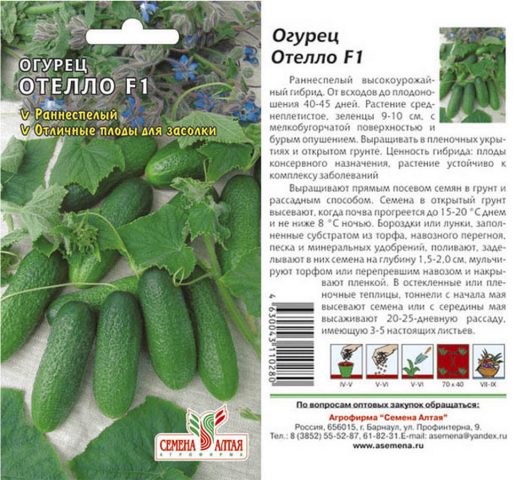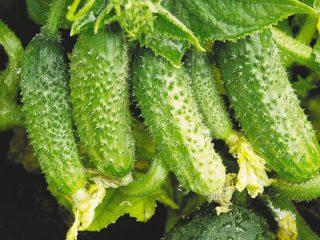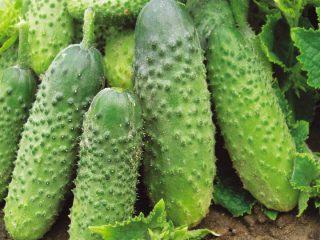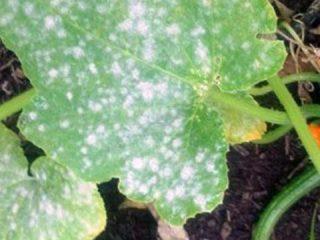Content
Othello cucumber is an early hybrid variety that requires pollination. This is the development of Czech breeders, which became famous in the 90s. The variety was included in the State Register of the Russian Federation in 1996. The originator is the Moravossed company. According to its characteristics, the cucumber is recommended for cultivation in the Southern regions, Northwestern regions, the Urals, and central Russia.
Description of the Othello cucumber variety
The vegetable bush of the Othello variety is highly branched and medium-climbing. The main stem is powerful, reaching 2 m. The crop can be grown in a vertical or horizontal position. Attaching the lashes to the supports is necessary for full development. Strong thickening, without access to light and air, can provoke rotting of the fruits.
The variety is distinguished by female flowering. The flowers are yellow, bell-shaped. Up to 6 ovaries are formed in one sinus. The foliage is dark green and small in size. The growing season of the Othello cucumber takes 40-45 days.
Detailed description of the fruits
Summer residents speak positively about the taste of the Othello cucumber, and the external features are easy to see in the photo. The fruits are beautiful, smooth, bright green. There are light stripes on the surface. There are also spines and small tubercles. The skin is thin and tender.
The size of Othello cucumbers is 8-10 cm. However, they can be picked like gherkins at a length of 5-6 cm. When ripe, cucumbers have a neutral taste, no bitterness is felt. Internal voids do not appear even after over-ripening. The flesh is dense and crispy. You can hear the rich aroma of cucumbers.
The taste is sweet, delicate, delicious. It is most pronounced in fruits that are pickled or salted. The hybrid is excellent for preservation. Othello cucumber is also eaten fresh.
Main characteristics of the variety
Othello cucumber is undemanding to moisture. It has high immunity to common cucumber diseases. The vegetable easily tolerates transportation over long distances. They have high keeping quality. At optimal temperature and humidity parameters, they are stored for 30-45 days, without loss of taste properties.
Productivity
Othello cucumber is an early ripening variety. Technical maturity occurs already 45-50 days after seed germination. The hybrid gives good yields. From 1 sq. m get 8-10 kg of elastic fruits. Vegetable crops are grown in greenhouses and vegetable farms, since the marketability of cucumbers is 98%.
The fruiting of Othello cucumbers can be affected by unfavorable weather conditions: prolonged rains, downpours, bad weather. If the plant is not properly pollinated. There is no access for bees or artificial pollination is performed poorly. In such cases, the yield of the hybrid variety is significantly reduced.
Resistance to pests and diseases
Othello F1 cucumber is a persistent vegetable. It can easily withstand sudden temperature fluctuations and solar activity. During periods of drought, it requires additional watering. The plant has strong immunity. Othello cucumber is resistant to powdery mildew, cucumber mosaic virus, cucumber blight, and cladosporiosis. When transplanted, the hybrid quickly adapts to new conditions. Fruits are not prone to overgrowth if harvesting is not done in a timely manner.
The hybrid Othello cucumber is attacked by aphids and sprout flies. The fight against these insects consists of preventive treatment of the plant with chemicals or safe folk remedies.
Pros and cons of the variety
Russian gardeners have been appreciating the Othello cucumber variety for 10 years and do not want to change it to new products of foreign selection. Advantages of vegetable crops:
- early ripeness;
- excellent taste;
- drought resistance;
- simultaneous fruiting;
- resistance to fungal diseases;
- lack of bitterness in the pulp;
- good transportation;
- possibility of growing in open and closed ground;
- marketable condition.
This variety has few disadvantages: there is no possibility of self-harvesting. In closed soils, artificial pollination is necessary. Lack of resistance to adverse natural conditions.
Growing rules
According to reviews from gardeners, the Othello F1 cucumber is best suited for growing in open ground. You just need to follow a few rules: get healthy seedlings, choose a sunny place on the site, prepare the beds for planting vegetables. It should be additionally noted that in warm areas the stage of sowing seedlings can be neglected.
Sowing time
When determining the date for sowing Othello cucumber seeds, you should start from the place for permanent cultivation, and also take into account climatic features. Planting on the beds is carried out when the soil warms up to a temperature of + 14-15 ° C. Usually this is the last days of May or the first ten days of June. Then they count 25 days allotted for growing seedlings, and another 7 days from sowing seeds to germination. Thus, the approximate date for sowing the seeds of the Othello F1 cucumber is April 20-25.
If in the future it is planned to plant Othello cucumbers in a greenhouse, then the sowing time will be 20-30 days earlier. The soil in the greenhouse warms up much faster.
Selecting a location and preparing beds
Othello cucumbers like to grow in loose, light, breathable soils. If the soil on the site is clayey, then you will have to additionally add sawdust, sand, and rotted leaves to increase aeration. It is advisable to add natural components in the fall, so that in the spring the soil only needs to be dug up and loosened.
The ideal option for growing Othello cucumbers is warm loam or sandy loam enriched with organic fertilizers. Desired acid-base balance: slightly acidic or neutral soil.
Don't forget about crop rotation. The best predecessors for cucumbers are eggplants, peppers, cabbage, potatoes, carrots, and tomatoes.
The seeding depth for Othello F1 cucumber seeds is 2 cm. It is recommended to plant seedlings in unheated greenhouses or open ground. Only 2 weeks before transferring young plants to a permanent place, they are hardened off.The duration of the air procedures is 15 minutes; after 5-7 days, the seedlings are left outside all day.
How to plant correctly
The planting scheme for hybrid cucumbers implies a distance of 70 cm between plants. It is better to arrange them in a checkerboard pattern. For 1 sq. m can accommodate up to three bushes.
When planting seedlings, follow the algorithm of agrotechnical practices:
- make a shallow hole;
- a seedling is placed in the center;
- sprinkle the roots with soil;
- lightly press the soil;
- fall down abundantly.
Important! Since the procedure is performed after the end of spring frosts, the plants do not need shelter. In the future, watering should be carried out based on weather conditions.
Aftercare for cucumbers
Judging by consumer reviews and the official description of the manufacturer, the Othello F1 cucumber variety is not demanding of care. You only need to follow standard agrotechnical rules.
- Water Othello cucumbers in the morning or evening. Use clean, settled, warm water. It is important to prevent moisture from getting on the surface of the leaves.
- In hot weather, water the vegetable crop daily. At low air temperatures, once every 2 days is sufficient. Cucumbers do not tolerate excess water.
- Be sure to remove any crust that appears after each moistening. Loose the soil immediately after absorbing the liquid.
- You need to regularly weed the beds with Othello F cucumbers. Overgrown weeds create shade and take nutrients from the soil.
- The hybrid loves fertilizers, but they need to be applied in moderation. 5 procedures per season will be enough. Chicken manure, mullein or complex mineral fertilizers are chosen as fertilizers.
- During the active growth period, the lashes of Othello cucumbers are attached to supports. Vertical structures are installed on opposite edges of the bed.A string is stretched between them, to which the twine lowered down is attached.
- Without tying, it will be difficult to collect fruits and care for the bushes. The fruiting of Othello cucumbers will also decrease.
- You cannot delay harvesting. Otherwise, the fruits will overgrow and the skin will be hard and yellow. Othello F1 cucumbers are harvested every 2-3 days.
Conclusion
The Othello cucumber has many advantages and many fewer disadvantages. The variety requires standard care. Suitable for growing for beginners. It is better to plant in garden beds as seedlings. This way, fruiting will occur faster, and in closed soils it will be necessary to artificially pollinate the flowers. Small, dense cucumbers with pimples will look nice in a jar.
Reviews of the Othello cucumber variety












